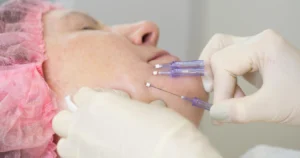

Chemical peels are among the most popular treatments for acne and other skin conditions. They are also widely used for cosmetic purposes. The main benefits of chemical peels are that they can be used to treat various skin conditions, and they can be done in clinics and medspas in a few minutes.
However, a few misconceptions have arisen about chemical peels that may lead some people to avoid them altogether. Many people believe that chemical peels can cause serious side effects such as burns, scars, damage to the skin, and other complications.
But if social media influencers and celebrities frequently use the treatment, then surely it must be effective, right? If it does work, to what extent will it be able to benefit you? To dispense the misconceptions, we have to discuss all the aspects of chemical peels.
Chemical peels are a superficial chemical treatment that removes the top layer of skin to reveal healthier, fresher, and younger-looking skin.
Chemical peels are used as a way to rejuvenate the skin. They can be used for people who have aged or sun-damaged skin. They can also be used to treat acne and other inflammatory conditions. Depending on the chemical peel you are using, it may also treat rosacea or hyperpigmentation.
Chemical peels are effective on the face, neck, chest, hands, and feet.
Chemical peels are used to remove dead cells and other debris from the skin. This process can be done at home or in a professional setting. They work by dissolving the top layer of the epidermis with chemicals, leaving the epidermis below intact. This allows new cells to grow in their place and naturally rejuvenate your skin.
The process is done by applying a chemical agent, usually acid, onto the skin and then waiting for it to react with the top layer of skin. The process can take anywhere from five minutes to an hour, depending on how deep the chemical is applied. Chemical peels are often used as part of an anti-aging or anti-acne routine, but they can be applied for other purposes such as acne scar removal and reducing wrinkles.
The solution for the treatment may contain acids, enzymes, or other chemicals applied to the skin to remove dead skin cells and stimulate new cell growth. This process can be repeated multiple times per week for weeks or months.
There are different chemical peels you can use to improve your complexion. However, you won’t have to worry about troubling which one best suits your needs. Your provider will do that job for you, and they can accurately determine which type of chemical peels best suits your needs.
Here are the different chemical peels that your provider may apply to your skin:
Light chemical peels are superficial chemical peels that remove the top layer of the skin without affecting the deeper layers. This chemical peel is typically used for mild acne and fine lines.
Light chemical peels have a lower risk of causing swelling, redness, and irritation than other peels since they only target the top layer of skin. They also don’t cause any significant downtime, making them more popular among busy people who want to look good but don’t want to spend too much time on their appearance.
The treatment is safe to use on sensitive areas near your mouth, nose, and eyes. This chemical peel is so light that you can try the treatment again after two to five weeks.
Medium Chemical Peel removes the epidermis and top layer of the dermis, a process that causes controlled injury to the skin. It is then followed by the healing and regeneration of new cells. The medium-depth peel has been used for decades.
Still, recently it has been gaining popularity due to its increased effectiveness in treating acne scarring, age spots, sun damage, hyperpigmentation, rosacea, and other skin conditions.
A deep chemical peel helps in providing a new and improved appearance to the skin by removing the epidermis and several upper layers of the dermis. It’s the most potent chemical peel you could have, so its effects are undoubtedly substantial.
Benefits:
Deep chemical peels are a whole new league of their own, and that’s why it has a list while light and medium chemical peels didn’t have one.
Chemical peels can be pretty expensive, costing you $100-$300 for a light chemical peel, medium costs $1,000–$3,000, and deep chemical peels can go as much as $2,500–$6,000.
The current average cost for a chemical peel is $519.
Chemical peels have been around for decades, and they have been proven to be safe when used by trained professionals. However, there is always a small risk, just like any other chemical peel treatment.
There are many things to consider before undergoing chemical peel treatments. For example, you should ensure that you do not have any allergies or sensitivities to chemicals or other substances found in topical medications like benzoyl peroxide or salicylic acid. You need to consult with your doctor about whether it is safe to undergo these treatments.
Even if you have no allergies to these chemical solutions, there are still risks of side effects. Some side effects of chemical peel may also include irritation, swelling, and redness.
To reduce or even eliminate the effects of chemical peels, you need to follow your provider’s instructions in detail faithfully. Your provider will offer some instructions on how you should wash, how often you can wash, which moisturizer to use, and which skincare products you can use.
You’ll also be recommended to avoid sunlight as much as possible until your skin is healed. Likewise, you will also need to avoid makeup until your provider gives you the go-ahead. You may use ice packs or a cool fan to help minimize the discomfort once you get home.
If you are interested in the chemical peel treatment, contact and reach out to our clinic, Bloom MedSpa. We offer services that help our clients achieve their aesthetic goals.